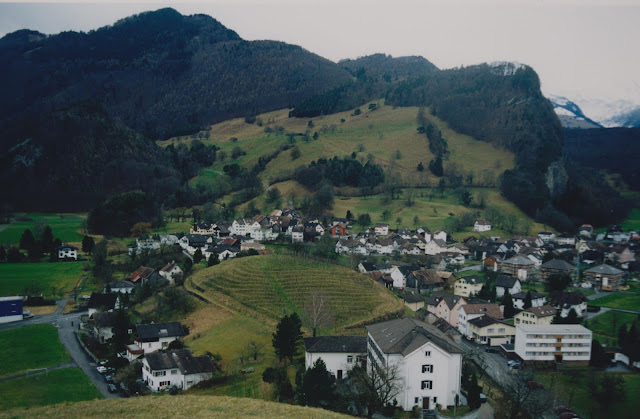With the ever increasing number of restaurants and eateries
around Dhaka , there’s no question that dining
out is popular. Whether for a special occasion or no reason at all, people like
to take a short drive or wander down the road to their favourite place for a
meal. It’s hardly an uncommon activity worldwide. But in Switzerland ,
dining out sometimes takes on a whole new meaning.
“Is there anything in particular you want to see while
you’re here?” my friend Mäggi asked, at her house not so far from Zurich .
I said I wouldn’t mind seeing Liechtenstein . There was something
appealing about the idea of a tiny country, at 160 square kilometres less than
half the area of Manpura Upazila in Bhola and home to just 35,000 people. Liechtenstein is a principality that had somehow
managed to retain its independence through centuries of war and upheaval in Europe . Liechtenstein
has the highest gross domestic product per capita in the world. Liechtenstein is but part of a valley and a few
mountains, with the upper reaches of the Rhine River
Distances are short in Switzerland . To travel ten
kilometres is considered a bit of a journey, Mäggi said, and to travel much further
than that is likely to involve crossing canton and perhaps even linguistic
boundaries within the country. That valley away to the right, she pointed out as
we drove along the highway, was the canton of Glarus, while the highway itself
was in St. Gallen; and Glarus was the first canton to lower the voting age to
sixteen.
Distances, meanwhile, are rather long in Australia .
Outside the cities to travel one hundred kilometres is barely worth a thought,
so I certainly had no difficulty with the fifty kilometres, about forty five
minutes, to Liechtenstein .
Fortunately Mäggi is exceptional, and didn’t mind distances either since she
likes to travel, and along with the particularities of Swiss living we
reminisced about our first meeting, by chance, years before, in the desert of Rajasthan
And of course distances are never the only consideration. We
were also considering that evening’s dinner.
It was unsurprising. We drove across a small bridge over the
Rhine and there we were: Liechtenstein .
To the untrained eye it looked exactly the same as the Swiss side of the
valley. Mäggi had chosen to reach the southern village
of Balzers first, home to around 4,000
people, because on a small hilltop in the valley, in the centre of the village,
was Gutenberg Castle
We walked around the castle’s bailey, the enclosed
courtyard, shivering in the winter air and admiring the grey-sky view from its
walls. In those identically Swiss shades of verdant green, grey rock and white
snow, was the landscape of a valley rimmed by the peaks of the Alps . Of course it was stunning but it could have been
just about any valley thereabouts. But on the other hand, it was Liechtenstein .
I couldn’t help but wonder what percentage of the country it
was, that was contained in that singular view. It certainly wasn’t all of it
since Liechtenstein
continues for several mountaintops to the east which were out of sight, but it
may have been most of it. I don’t suppose there are too many places in the
world where it’s possible to view the best part of an entire country from the
one spot.
From Balzers in the far south of Liechtenstein
we continued to the capital, Vaduz ,
also on the Swiss border but north, in the middle of the country – a distance
of 7.5 kilometres. The capital, home to about 5,000 people, was quiet and
orderly, and spotless to the degree I always think makes it seem as though
nobody really lives there – what could be called ‘showcase clean’. On the hill
to the east overlooking the town was Vaduz
Castle
The foremost attraction in Vaduz is likely the Kunstmuseum
Liechtenstein, the principality’s collection of modern and contemporary art. A
few hours passed that way, bringing with it that contemplative mental stillness
that usually comes about from taking in the various concepts and imaginings on
offer at an art gallery.
By then it was already late. It was dark. An afternoon in Liechtenstein
was done and there was only the matter of dinner left to consider.
It’s hardly controversial to remark that Switzerland is
expensive. What was perhaps surprising was that it is also expensive for many
Swiss. And if you’re like Mäggi and not averse to distances, even distances
that might be considered relatively minor elsewhere, then dining out can just
as easily mean dining out of the country.
It had made economic sense on a previous day to reach the
town of Konstanz ,
about fifty kilometres northeast of Mäggi’s house and just across the German
border, for lunch. A little further, two hours’ drive to the south from her
house was the temptation of Italy .
But on the day of the visit to Liechtenstein
the sensible choice was to take the opportunity to cross into Austria , where,
immediately beyond the border post and before nearby Feldkirch town, are a
string of restaurants catering to hungry Swiss and Liechtensteiners. And there,
for old time’s sake, for a chance meeting in Rajasthan, we chose the Indian
place.
In Switzerland
But the question is: What to Eat?
The choice is yours.
This article also published in Star Magazine, here: Dining Out


































